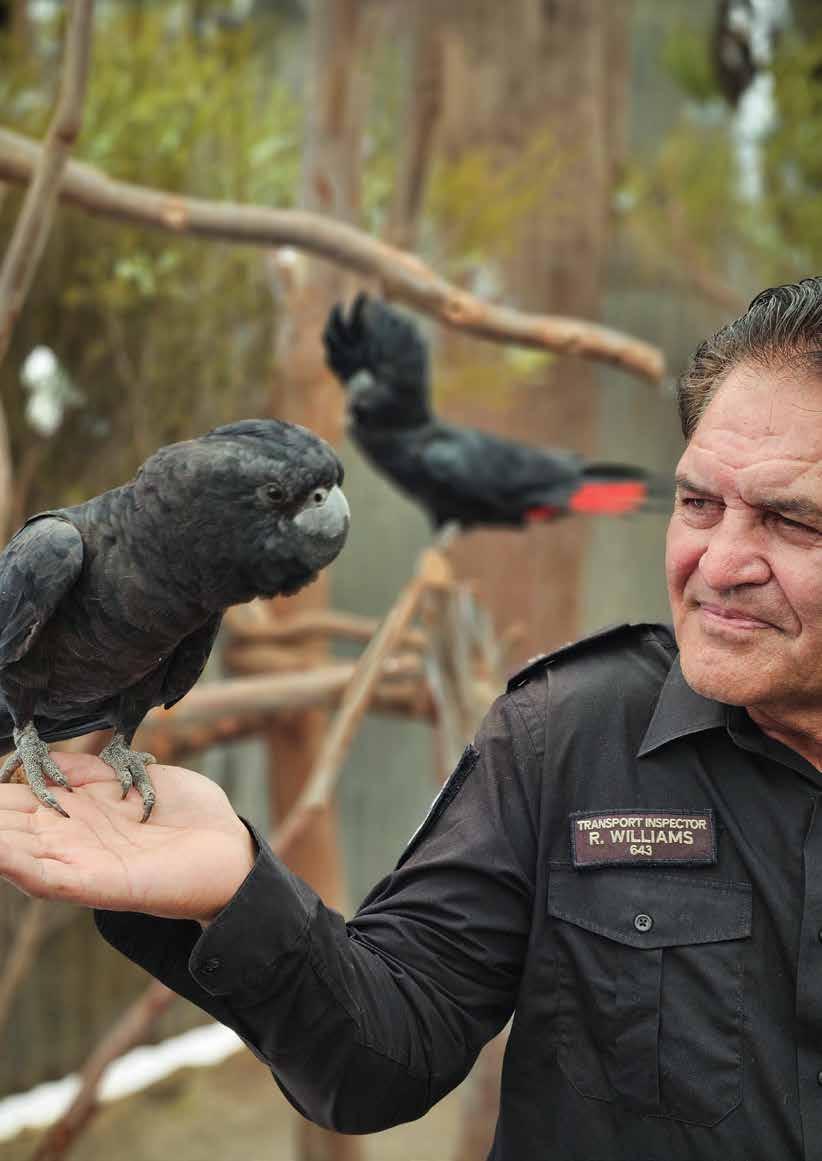
THE TRANSPORT AND MACHINERY MAGAZINE OF WESTERN AUSTRALIA | Since 1994 100007516 April 2024 | price $8.95 ISSN 2202-6193 IN THIS ISSUE: Secrecy over road safety data • Right to disconnect laws for transport Dealing with DoT • How will we solve truck driver shortage? Page 9 EFFORTS TO SAVE COCKATOOS Inspectors actively patrol and enforce load restraint of grain loads in order to save birdlife who feed off spillage Inspector R. Williams with Black Cockatoo ‘Sammy’


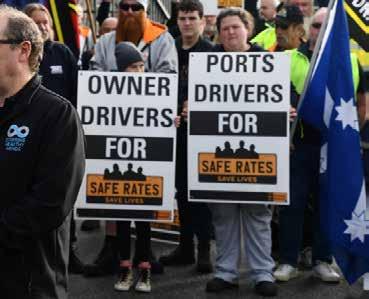


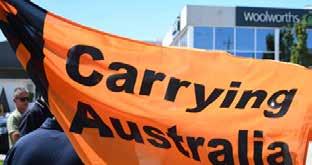
At the TWU, we are relentless in the pursuit of building and exercising worker power, guided by clear, strong principles. We are committed to earning and keeping our members’ trust and bargaining collectively. We aim to hold corporations to account, empowering the workforce with a strong and powerful voice.
The TWU has a number of Enterprise Agreements in a myriad of transport companies. If you work for a company that has an EA with the TWU, you, along with all transport workers benefit from the years of struggle and collective action of union members before you.

And set the standard for transport workers into the future.
TWU Members also benefit from a range of services available only to members
Legal Services
Wage increases and improved conditions through collective bargaining
Enforcement of your agreement and workplace rights
Representation for incidents or disciplinaries
Job Security and protection
$5,000 Funeral benefits
Free Wills
Extraordinary Driver’s License
www.twu.com.au/join
Income Protection and Group Accident and Sickness cover
Collective purchasing power of UnionShopper to provide members with discounts on a range of restaurants, gift cards, white goods and more
You should be a member of your union, the TWU if you enjoy these benefits like:
Annual Leave
Maternity Leave
Long Service Leave Sick days
Leave loading
Penalty rates
Superannuation
Health and safety and workers’ compensation
Allowances (meal allowances, shift allowances)
Rest breaks Unfair dismissal protection
Becoming a member of the TWU ensures you can maintain these rights into
UNION T RANSPORT WORKERS‘ NOT A MEMBER? JOIN TODAY
the future.
& POWERFUL VOICE
WORKERS’
A STRONG
FOR TRANSPORT

3 WATM • October 2021 Talk to us about: The Heavy Vehicle Helpdesk is open from: 7am to 6.00pm Monday to Friday and 7am to 3.30pm Saturday, Sunday and WA public holidays. Main Roads Heavy Vehicle Services 525 Great Eastern Highway REDCLIFFE 6104 Tel: 138 486 Fax: 9475 8455 Email: hvs@mainroads.wa.gov.au www.mainroads.wa.gov.au Our Heavy Vehicle Helpdesk is available 7 days a week. Permits OSOM movements Traffic Escort bookings Accreditation Route Assessments Compliance

Australia is experiencing a scarcity in truck drivers that poses a serious threat to the future of our country’s road-freight industry.
As of February 2023, online jobs platform SEEK has posted more than 22,000 vacant positions for truck drivers in Australia, highlighting a driver-scarcity problem that poses a serious threat to the future of our country’s road-freight industry.
As the last few years of pandemic lockdowns have highlighted, it’s a fragile industry that has the potential to derail supply chains when disrupted, especially when you throw things like a worldhalting virus and a huge increase in online shopping into the mix.
According to SEEK, the average salary of a road-train driver is between $105,000 and $125,000 – although a Northern Territory haulage company has offered a salary as high as $150,000 to attract drivers – which
suggests the problem isn’t the pay.
One key issue contributing to the shortage is an ageing workforce, with the average age of truck drivers falling between 45 and 54, and less than 15 per cent of drivers are under the age of 30.
According to Australian Trucking Association chair David Smith, new training initiatives are crucial to the future of the industry. “It’s no secret that operators around the country have difficulty recruiting truck drivers,” says Smith.
“There is a shortage of new starters in the trucking industry, and it’s due to the image of the industry and the image of truck driving as a career. By improving the professionalism of the industry, strengthening driver training would make driving a more attractive career.”
Last year, the federal government approved a heavy vehicle driving apprenticeship designed to teach driving
By Shell
How will Australia solve the truck-driver shortage?
skills, safety, administration and digital skills. Australian Industry Standards (AIS) chief executive officer Paul Walsh, a former truck driver, says the two-year apprenticeship, which gives the recipients a heavy-rigid truck licence, a forklift licence and more, is the kind of thing that’s sorely needed to raise the profile of truck driving as a viable career.
“In 10 years, I’ve never had a piece of work we’ve done that’s created more interest from industry,” Walsh says. “It tells us something about the value of apprenticeships. We know this has industry support. We’re getting people from industry calling us pretty much every day saying, ‘When can we get going? Where can we sign up?’"
Northern Territory truck driver Epick Webb says a widespread driver shortage has been an issue for the past 20 years, and that a lack of training isn’t the only issue. “Many people – including employers – don’t
Focus 2 WATM • April 2024
actually realise how much of everyday life depends on the services of road transport and its drivers, meaning truck drivers don’t actually get compensated in accordance with the work involved,” says Webb.
Other issues he lists include poor pay when taking into account the dangers involved with the job, poor facilities, including a lack of clean toilets, showers and meal rooms, not enough parking options and issues regarding insurance.
Lack of diversity has also been cited as something that needs addressing, with women accounting for only three per cent of the truck-driving workforce.
“The industry will need to find over 30,000
people by 2027 to fill the vacancies – that is a massive number,” says the AIS’s Walsh.
“So how do we try to bridge that gap? We’ve got some real challenges in front of us. I see the gender distribution as an opportunity… [we need to] make it more attractive for females to get into the industry.”
Women in Trucking Australia (WiTA) has been established in order to get more women behind the wheels of big rigs, with a special ‘foot in the door’ program established to link already licensed, inexperienced female drivers who’ve not been able to get that critical first break with training organisations and employers nationwide.
Victorian Transport Association chief
executive officer Peter Anderson has also called for heavy-vehicle drivers to be added to Australia’s Priority Migration Skilled Occupation List, to help address the shortage with drivers from overseas.
“Overhauling heavy-vehicle driver licensing to make it possible for young, qualified people to operate larger vehicles will help to resolve the domestic shortage of workers,” says Anderson.
“However, for Australia to attract competent and qualified heavy-vehicle drivers from overseas in the short-term, we need to change our skilled-migration program to prioritise this occupation over others.”
The transport industry needs more than an immigration boost
Jamie Dixon, director of Supply Chain for TMX Transform says, “The immigration surge may seem like welcome news given the shortage of skilled heavy vehicle truck drivers in Australia.
“This labour shortage in trucking is persistent. The freight, logistics, and supply chain industry accounts for 8.6% of Australia’s GDP, and more than twothirds of non-bulk domestic freight is carried on roads.1
“Truck drivers are business critical. They are the glue keeping the country’s supply chains running. But inadequate staffing levels can represent major business problems with flowon impacts, compromising service delivery, timeframes, and customer experience. Boosting driver numbers via immigration is sometimes posed as a possible solution.
“Australia’s migration rebound is well and truly here after years of closed borders across 2020 and 2021. For the 2022-2023 financial year, Australia net gained 518,000 migrants, with arrivals increasing almost two-thirds (73%) compared to 12 months earlier1. Not only are more migrants arriving, but
less are leaving our shores, with migrant departures decreasing to 219,000 from 223,000 (2%).
But of the immigrants who find work in the road freight industry, most are entrylevel, driving vans and small trucks.
A long-haul problem
The main issue is the shortage of long haul and heavy vehicle drivers, and there are multiple contributors to this situation, including Australia’s ageing population. The average age of long-haul drivers is around 50, and the retirement age is mid-50s.
As of February 6, 2024, there are 20,473 truck driver jobs advertised on Seek.com.au2. With about 200,000 truck drivers working in Australia, online job advertisements from just one website –which does not account for all required roles – are looking to increase the workforce by at least 20%. Twelve months ago, the numbers were similar3
The United Kingdom famously demonstrated the impact on trucking when immigration policy significantly changes. Brexit, the UK’s decision to withdraw from the European Union, meant thousands of foreign truck drivers departed the UK, with their supply chain, and therefore Brits,
suffering the impact of shortages as a result.
In Australia, the opposite is being touted as a saving grace – that an immigration surge may be the answer to the problem. But the numbers don’t necessarily back it up.
Looking into the crystal ball
In a review of heavy vehicle rest areas
TMX completed last year for Healthy Heads in Trucks & Sheds (HHTS), a non-for-profit which aims to improve the wellbeing of national transport, warehousing, and logistics workers, TMX found there are many areas for improvement to attract workers to the profession, such as establishing a national heavy vehicle rest area strategy, including a minimum set of standards for heavy vehicle rest areas. The road and rest areas are the workplace of truck drivers, and they must be treated with the same level of attention as a whitecollar office.
Road freight is expected to grow by 56% by 2040 in Australia, the TMX report found. This is a challenge that will not go away on its own, but the businesses who rely on truck drivers can help shape the solution.
1 Freight & supply chains, Department of Infrastructure, Transport, Regional Development, Communications and the Arts
Overseas
3 WATM • April 2024
2
migration, Australian Bureau of Statistics, Dec 2023 - Overseas Migration, 2022-23 financial year | Australian Bureau of Statistics (abs.gov.au)
3 Truck Driver Jobs in All Australia - SEEK
4 The truck driver shortage in Australia – Shell

IKaren-Maree’
T:
Email:
WRITERS
Karen-Maree'
Jan
Angry
T:
T:
E:
PRINTER
Daniels Printing Craftsmen
SUBSCRIPTIONS
Subscriptions available directly from the Publisher.
T: 0430 153 273
E: karen@angrychicken.com.au
Australia: 1 year $130 (inc GST)
Overseas subscribers: Airmail postage will be added to subscription rate.
Editorial Submissions: The Publisher welcomes editorial submissions. Once received they will become the property of the Publisher who reserves the right to edit the or adjust the content to fit with the format of our publication.
West Australian Transport Magazine (WATM) is published by Angry Chicken Publishing Pty Ltd
ABN: 35 486 530 095 All rights reserved. No part of this publication may be reproduced, adapted or transmitted in any form by any process (graphic, electronic, mechanical or storage and retrieval system) or sold, resold or otherwise exploited for any purpose without consent of the Publisher.
The publisher, contributors, editors and consultants disclaim any and all liability and responsibility to any person or party, be they a purchaser, reader, advertiser or consumer of this publication in regards to consequences and outcomes of anything done or omitted, or being in reliance whether partly or solely on the contents of this publication. No person, organization or party should rely on or on any way act upon any part of the contents of this magazine without first obtaining the advice of a fully qualified person. The Publisher shall have no responsibility for any action or omission by contributor, consultant, editor or related party for content within WATM. The opinions and content within WATM does not necessarily reflect those of the Publisher, editor or their agents. No responsibility is accepted for damage or loss of material supplied to the publisher.
t looks like there has been no improvement in the truck driver shortage; in fact the grumblings have got louder and added to this the reports of accidents around the state seem to be nonstop. In this edition we look at ‘How will Australia solve the truck driver shortage’. More training seems to be the answer, but it is going to take an ‘all industry’ shake up to be able to attract new people into wanting this as a career path. We also look at immigration which has increased expedientially. Is it a part of the solution – or not?
I hope you like our front cover and many thanks to Main Roads for supplying the image of Transport Inspector R. Williams with the Black Cockatoo ‘Sammy’. I imagine many of you looked at it and thought, “What has that got to do with transport”? However, if you head across to page 9 please read about the rules and fines for not securing your grain loads and ‘why’
it is important that no grain falls onto the road or roadside as the local bird life, especially the Black Cockatoo feed on it and are subsequently hit by passing vehicles.
With the multi-national Supermarkets in the spotlight, Ray Pratt talks about the exploitation of our two most essential industry segments – farmers and the transport industry. Cam Dumesny from WRF asks, “How many more freight disruptions do we need before the politicians care?” and the LRTAWA introduce us to their newest life member – Rod Stanbishop.
Thank you to everyone who supports assists and reads the magazine. It is appreciated, and next month we will bring you full coverage from the Mack Muster show.
Best,
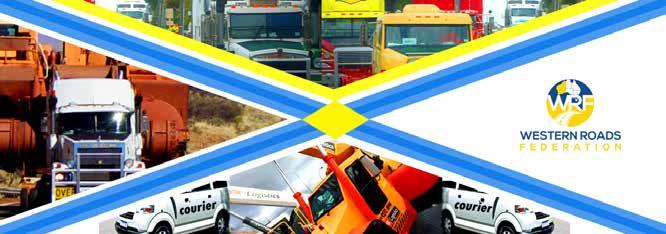
4 WATM •
4
WA TRANSPORT magazine VOLUME 30 | NUMBER 3 Angry Chicken Publishing Pty Ltd Telephone 0430 153 273 www.angrychicken.com.au ABN: 35 486 530 095 FROM THE PUBLISHER Contents 2 How will Australia solve the truck driver shortage? 3 The transport industry needs more than an immigration boost 6 Westport environmental assessment underway 7 Secrecy over road safety data 8 Upgrades continue on vital Perth to Kalgoorlie link 9 Grain transport by road and the efforts to save Cockatoos 12 National Level Crossing Safety Roundtable 13 Skills for a decarbonised future – a survey 14 Western Roads Federation – How many more freight disruptions do we need before politicians care? 16 Clarification of ‘right to disconnect’ laws within transport sector 18 Nominations open for Work Health and Safety excellence awards 19 LRTAWA: Rod Stanbishop – If you take, you should give back –words to live by 20 The rail industry needs to stop redirecting blame Karen PUBLISHER / COMMISSIONING EDITOR
Kaye
153
0430
273
karen@angrychicken.com.au
Kaye,
CONTRIBUTORS
Russell McKinnon
Cliff
Carol
ADVERTISING ENQUIRIES
Cooper, Cam Dumesny,
Graham,
Messenger, Ray Pratt
Chicken Head Office
0430 153 273
karen@angrychicken.com.au
/ PREPRESS
Browning
Bare Creative ACCOUNTS
E:
DESIGN
Cally
|
0430 153 273
accounts@angrychicken.com.au
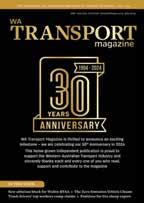

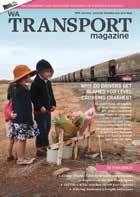


Our digital editions (11 per year) are available at ‘no cost’ and to subscribe please email karen@angrychicken.com.au
You will receive a monthly email from us and be given a link to a high quality Flip Book that you can download and access any links within the publication.
We do not make any profit on our subscriptions. Due to the rising costs of postage and producing the magazine we charge only ‘what it costs us’ to print and post your publication to you.
To receive the hard copies, please email karen@angrychicken.com.au with the following details and you will receive an invoice with EFT details:

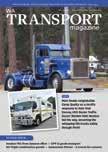
WATM 5 DIGITAL EDITIONS (11 per year) FREE OF CHARGE HARD COPIES ~ (11 per year) $130 T 0430 153 273 | www.angrychicken.com.au Name Company Postal Address Phone Email Angry Chicken Publishing Pty Ltd WA Transport Magazine has always endeavoured to make the publication ‘free’ to readers.
WANT TO PAY BY CREDIT CARD? Visit www.isubscribe.com.au/wa-transport-magazine-subscription.cfm Note, this option costs $140 (one year) and the price includes ISUBSCRIBE fees on top of $130 base cost (printing and postage only). Thank you for your understanding and support of an independent publisher who has been producing the WA Transport Magazine for 30 years
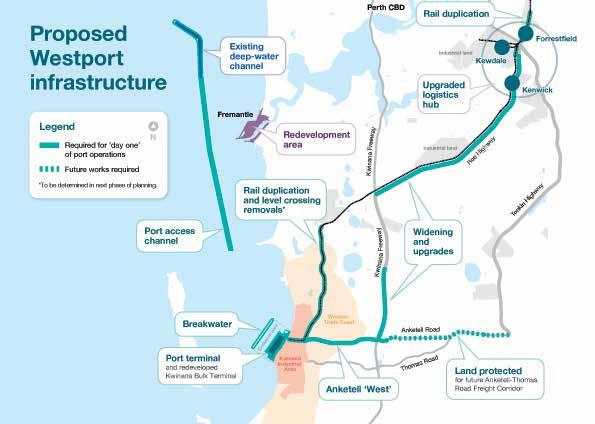
Westport environmental assessment process underway
Westport has reached another significant milestone with the proposed marine and landside port infrastructure within the Kwinana Industrial Area referred to the Western Australian Environmental Protection Authority (EPA) to determine the level of environmental assessment.
Westport's referral documentation outlines the scope of the proposal, which includes:
• port facilities, comprising an area of reclaimed land in Cockburn Sound
Rand connections to road and rail infrastructure in the Kwinana Industrial Area;
• a shipping channel into Cockburn Sound to accommodate larger container vessels expected in the future; and
• an offshore breakwater required to protect ships berthed at the proposed terminal.
Referral marks the first step in the environmental impact assessment process which is expected to take around two years. The EPA is anticipated to publish Westport's referral document in the coming weeks and invite public comment on the level of assessment.
Given the significance of the project to the State, the importance of the environmental values in Cockburn Sound and the scale of the infrastructure, Westport is requesting the EPA to undertake the highest level of assessment - Public Environmental Review.
It is anticipated that Westport's Public Environmental Review documentation will be made available for public comment in 2025.
Main Roads will submit a separate referral to the EPA for upgrading Anketell Road, from Leath Road to the Kwinana Freeway, to support freight requirements for the Western Trade Coast and the future port in Kwinana.
Two new rail upgrades to boost grain transport
ail siding upgrades through the $200 million Agricultural Supply Chain Improvements (ASCI) Program are continuing to roll out, with projects at Cranbrook and Konnongorring to start construction in April.
It comes after Co-operative Bulk Handling (CBH) Group awarded construction contracts for the two projects to Laing O'Rourke (Cranbrook) and DT Infrastructure (Konnongorring).
ASCI is jointly funded by the State and Commonwealth Governments to deliver supply chain efficiencies through rail freight infrastructure upgrades. Package 1 of the program includes $68 million to upgrade 11 rail sidings at CBH Group grain receival sites, with additional investment from CBH.
Upgrades at the Cranbrook site include extending the length of the rail siding to allow 60-wagon trains to be
loaded off the main line in four hours. CBH will also install a fixed rail loading facility at the site. The infrastructure upgrades are expected to increase the site's monthly grain export capacity by 164,000 tonnes.
At the Konnongorring site, the rail siding upgrade and extension is expected
These two projects will have a transformative impact on both our grain export capacity and community amenity ...”
~ Rita Saffioti
to contribute to reducing loading times for a 52-wagon train from 14 hours to around four hours. The works will transform Konnongorring from being a predominantly road-based transport site to a rail and road site.
The Konnongorring upgrades are due to be finished by the end of the year and
the Cranbrook project in the third quarter of 2025.
Brookton was the first of the ASCI rail siding projects to be completed in August last year. The project wrapped ahead of schedule, with the upgrades doubling the amount of grain loaded onto wagons in less than half the previous time.
Work on upgrading the Broomehill site is entering its final stages and when complete, will also streamline grain handling and loading by cutting hours off loading times for larger wagon trains.
Transport Minister Rita Saffioti said, “These two projects will have a transformative impact on both our grain export capacity and community amenity, allowing hundreds of thousands more tonnes of grain to get to port and command the best prices for our growers, while taking more trucks off our roads.”
News 6 WATM • April 2024
Secrecy over road safety data
Australia’s increasing road toll demands action to end secrecy over data that could explain what is going wrong on the nation’s roads, the Australian Automobile Association has said.
The AAA is leading a national campaign for the Australian Government to use the new land transport infrastructure agreement that is being negotiated to compel the states
to publish road safety data.
AAA Managing Director Michael Bradley said, “Data needed to understand the causes of our increasing death toll is collected by state and territory governments, but it is not being reported, or shared.
“This critical information describes the quality of Australian roads, the causes of crashes, and the effectiveness of each
state’s road rules and enforcement regime.
“Without this data Australia has no credible plan to understand its current road trauma problems or prevent their continuation,” he said.
There were 1,257 deaths on Australia’s roads in the 12 months to 31 January 2024, compared to 1,193 in the 12 months to 31 January 2023.
New design Rule for medium and heavy trucks
The Australian Government has issued a new lane departure warning design rule for medium and heavy trucks, Australian Design Rule 99/01.
The design rule will apply to all new model trucks weighing more than 3.5 tonnes from 1 September 2026 and to all new trucks weighing more than 3.5 tonnes from 1




September 2028.
According to ATA’s Senior Policy Adviser Chris Wren, "ADR 99/01 aligns Australia’s design rules with international standards, facilitating market access for vehicles meeting these criteria and promoting harmonisation.”
“The legislation underwent extensive consultation, with broad support for its implementation. Impact analysis
estimates show substantial safety benefits, including a reduction in fatalities and injuries, making ADR 99/01 a significant step towards enhancing road safety nationwide."
The Government also issued amendments to three existing ADRs: 99/00 – lane departure warning systems, 14/03 – devices for indirect vision, and 14/02 – rear vision mirrors.


WA’s premier brake and clutch specialists proudly servicing the states industrial clutch and brake applications.


From major truck workshops, heavy haulage, cranes, the mining industry and more… our team of knowledgeable and qualified technicians share over 100 years combined experience and focus on delivering prompt service alongside the supply of top name brakes and clutchesthroughout Australia and Asia.
With over 20 years in the industry we have a well-earned reputation for the development, manufacture and supply of quality standard and customised designs to suit a wide range of applications.

For the best advice and friendly service contact us today.
+61 8 9353 4411 ■ sales@knightbrakeandclutch.com.au knightbrakeandclutch.com.au







7 News WATM • April 2024 3 MINUTE EXPRESS WASH www.twepicton.com.au 24 HR / 7 DAY ACCESS • Road train friendly • Full chassi rinse standard • Credit card facility • Fleet accounts available Roadtrain / truck & dog $150 inc gst Semi $125 inc gst 6 Wheel Trucks / Bus $95 inc gst QUICK DRIVE THRU FULLY AUTOMATED TRUCK WASH 2 Nicholson Road, East Picton T: Darren 0417 909 128 | E: info@twepicton.com.au
Hopetoun Place, Welshpool, WA 6106
WA OWNED AND RUN 4
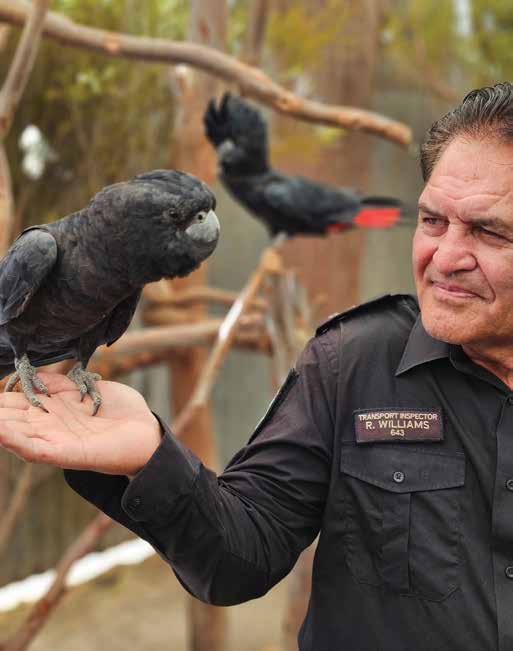
Grain transport by road and the efforts to save cockatoos
This article discusses the spillage of grain when transported by road and its implications for threatened birdlife, in particular cockatoo survival.
The harvest season commences each year on the first day of October and finishes on the last day of February. During harvest season Main Roads Transport Inspectors patrol across the Wheatbelt from Geraldton to Esperance. The focus is on these areas as harvest delivers the single largest movement of heavy vehicles in Western Australia during the year.
The Inspectors work with the transport industry to improve compliance standards, road safety and asset road protection across Chain of Responsibility which includes Mass, Dimension and Load Restraint, as well as vehicle
Major upgrades to Great Eastern Highway continue to surge ahead with a $24 million contract awarded for works on an 11-kilometre section of the road between Southern Cross and Ghooli, southwest of Kalgoorlie.
Link
Upgrades continue on vital Perth to Kalgoorlie
The contract award is part of the broader $250 million Great Eastern Highway Upgrade program, which is delivering improvements to various sections of the Highway through the Wheatbelt and Goldfields-Esperance regions.
The upgrades include overtaking lanes, intersection improvements, bridge replacement, road widening and shoulder sealing while work on the 11-kilometre section between Southern Cross and Ghooli
will include realignment, reconstruction, overlay and widening of the Highway to 11 metres.
The contract award comes as other major works on the Great Eastern Highway continue, including:
• Widening of 15 kilometres of highway around Bodallin and the construction of a new two-kilometre passing lane
• Widening the road near Moorine Rock Bridge with sealing and new guardrails being installed
• Intersection upgrades and widening of Parker Range Road have also begun with completion expected mid-2024. The staged upgrade program will continue along the Highway until 2028.
Federal Infrastructure, Transport,
8 WATM • April 2024 Main Roads News
Inspector R. Williams with Black Cockatoo ‘Sammy’
News
roadworthiness and licensing.
Chain of Responsibility legislation means that all parties in the transport chain such as consigners, drivers, operators, freight handlers and loaders, and prime contractors who are responsible for conduct that affects compliance and may have contributed to a mass, dimension or load restraint offence, can be held responsible for breaches of road laws and may be made legally liable.
The Road Traffic (Vehicle) Regulations 2014 require that:
• A load on a vehicle must not be placed in a way that makes the vehicle unstable or unsafe;
• A load on a vehicle must be secured so that it is unlikely to fall or be dislodged from the vehicle; and
• An appropriate method must be used to restrain the load on a vehicle.
It is an offence if a load is not placed, secured or restrained to meet the performance standards in the 2004 Load Restraint Guide.
The Road Traffic Code 2000 Section 257
‘Securing of loads’ states that:
“(4) A person shall not drive a vehicle that is carrying a load comprising grain, unless that grain is fully covered or enclosed.”
While the legislation does not specify a particular type of seal, it does confirm that it is the responsibility of a driver to ensure grain loads are fully covered/enclosed.
Main Roads Transport Inspectors and the WA Police are responsible for the on-road enforcement of load restraint breaches and take action when breaches
Regional Development and Local Government Minister Catherine King said, “The Australian Government is committed to ensuring a reliable, safe and efficient transport link between Perth and Kalgoorlie, and this project is an important step in that journey.
“We’re proud to be partnering with the Western Australian Government to improve the Great Eastern Highway, section by section, to ensure safe and reliable transport access for residents, freight movements and tourists.”
Western Australian Transport Minister Rita Saffioti said, “Great Eastern Highway is a vital freight link for Western Australians, which is why this extensive program of upgrades is so critical.
Main Roads News
Main Roads advised that the Inspectors actively patrol and enforce noncompliance of grain loads which are not secured or restrained
are detected during patrols.
At the commencement of the 2023/2024 season, Main Roads visited its grain receival partners under the Harvest Mass Management Scheme (HMMS). In these discussions Main Roads informed of the issues with spilt grain and the impact on our local birdlife, specifically the Black Cockatoo, which feed off the grain spillage on or near the road and are subsequently struck by passing vehicles, further endangering the species. Main Roads advised that the Inspectors actively patrol and enforce noncompliance of grain loads which are not secured or restrained. Both the grain receivers put quality control measures in place to encourage load restraint with visual inspections on arrival at the weigh stations. CBH conducted
“In the past few years, we've also upgraded 193 kilometres of Great Eastern Highway in the Wheatbelt including shoulder sealing between Northam and Walgoolan, upgrades between Carrabin and Bodallin and replaced four bridges in Coates Gully in the Shire of Northam.
“We’ve also recently opened the new Walgoolan Bridge, which is another important achievement.
“Our Government remains committed to upgrading and improving the regional road network, for all road users."
Senator for Western Australia Varun Ghosh said, “We are working with the Western Australian Government to invest in and upgrade the Great Eastern Highway, which is vital for essential, industry and
ongoing communication with clients, Bunge had a “shaker” for the trucks to drive over, and both parties actively swept trailers and spills in their compounds.
Under WA transport law the following fines can be applied where unsecured loads are detected: Up to $100, $500 or $1000 per infringement depending on severity (minor, substantial or severe).
During the 2023/2024 season which recently ended, the Main Roads Compliance team intercepted 78 grain movements and no grain related load restraint offences were detected.
By comparison, in the 2022/2023 season there were 196 grain movement interceptions and only one grain related load restraint offence was detected.
The outcome of the above findings is that the number of load restraint offences is very low in comparison to the number of grain movements throughout the harvest season. Load restraint breaches are low in grain trucks compared to other commodities such as building and construction materials over the same time period.
Environmental responsibility is of utmost importance to the Heavy Vehicle Compliance team who have a standard appointment with our grain receival partners each year and our Calendar of Enforcement Focus highlights the harvest season. Our Inspectors understand the importance of spilt grain and the unfortunate flow on effect it has on our local wildlife.
Main Roads encourages all road users to drive to the conditions, particularly on regional roads.
The upgrades include overtaking lanes, intersection improvements, bridge replacement, road widening and shoulder sealing
tourism travel between Kalgoorlie and Perth.
“This crucial investment by the Australian and Western Australian Governments will improve road safety and help to ensure that more efficient freight travel becomes a reality on one of WA's most significant highways.”
9 WATM • April 2024
Over to you
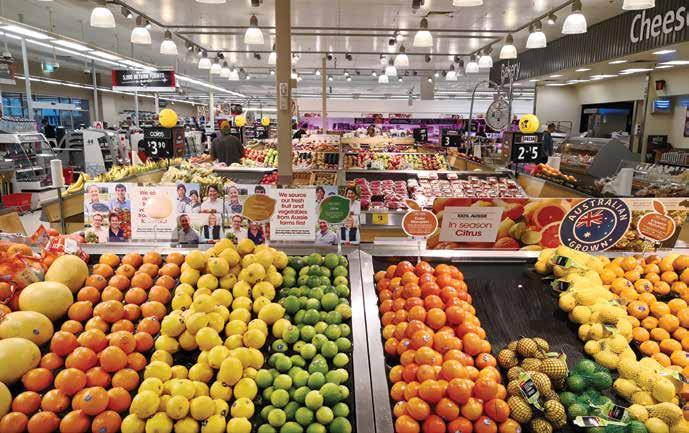
FMulti-national profits at expense of Farmers and the Transport industry
or too long now I have been critical of large multi-national companies exploiting truck drivers and driving down rates just so they can enjoy huge profit margins.
It’s come to no surprise to see recent media attention being drawn towards the fact that our hard working farmers are also being exploited with regards to supplying produce at rock bottom prices to these greedy companies.
Australian Farmers are an important segment of our economy as they provide most of the country's food at reasonable prices, and agricultural products are major exports.
These large retail companies are obviously in business to make big profits but it should not be at the expense of the hard working farmers and truck drivers who only want a reasonable return for their effort.
Farmers were expected to be able to provide a good supply of excellent quality product at the cheapest price. It’s obvious that these huge companies are getting too big and powerful for their own good and think that they dictate working conditions and poor payments.
If they are continued to be allowed to exploit good hard working people then eventually these good hard working people will move on which is exactly what is
happening with many long term family owned growers leaving the market because they struggle to break even – the same as is happening with transport operators.
My first recall of unfairness by a multi-national company was some twenty years ago when Coles acquired a lot of the Shell Roadhouses and then promptly shut down the restaurants. Many of these establishments were in remote towns all around Australia. This was a huge blow for all our hard working truck drivers as it took away more than fifty percent of places that we could stop and manage our fatigue, have a good meal and shower away from us. To us, they were a home away from home. All we were left with was somewhere to get fuel and fast food.
I wrote to Coles explaining that hard working truck drivers of which many were delivering to Coles supermarkets were disappointed and disadvantaged by losing the services of these roadhouses. The reply was that while they acknowledged the importance of truck drivers the roadhouses were not their core business as they were just interested in the fuel sales and fast food. Definitely not the answer I wanted to hear and certainly ‘not’ the Australian way.
Think back to the cheap milk saga price war where we were sold milk for a dollar a
litre. Both Coles and Woolworths and some of IGA stores got involved and the poor farmers suffered as a consequence. Luckily the media galvanised support in favour of the plight of the farmers and eventuality it was dropped. It certainly left a sour taste in farmers mouths as it threatening the viability of an important industry.
At that time, many farmers left the industry over this unnecessary incident.
I believe we should be vigilant and wary of these big companies as they try and get larger and more powerful. I thought Government were supposed to monitor these big companies and stop them having a monopoly.
I’m certainly in favour of supporting smaller companies where I can with my money. Farmers and truck drivers are hard workers and provide a valuable and necessary service to the community and if we are to survive we need to have proper recovery of our costs.
If we keep getting exploited by these multi-national companies then we will desert the industry which would not be good for anyone and will further impact the transport industry that is already in crisis due to a lack of drivers.
Like most people in this great country of ours all we ask for is a fair go. Keep it safe, Ray Pratt.
10 WATM • April 2024
A FAIR GO FOR OWNER DRIVERS by Ray Pratt





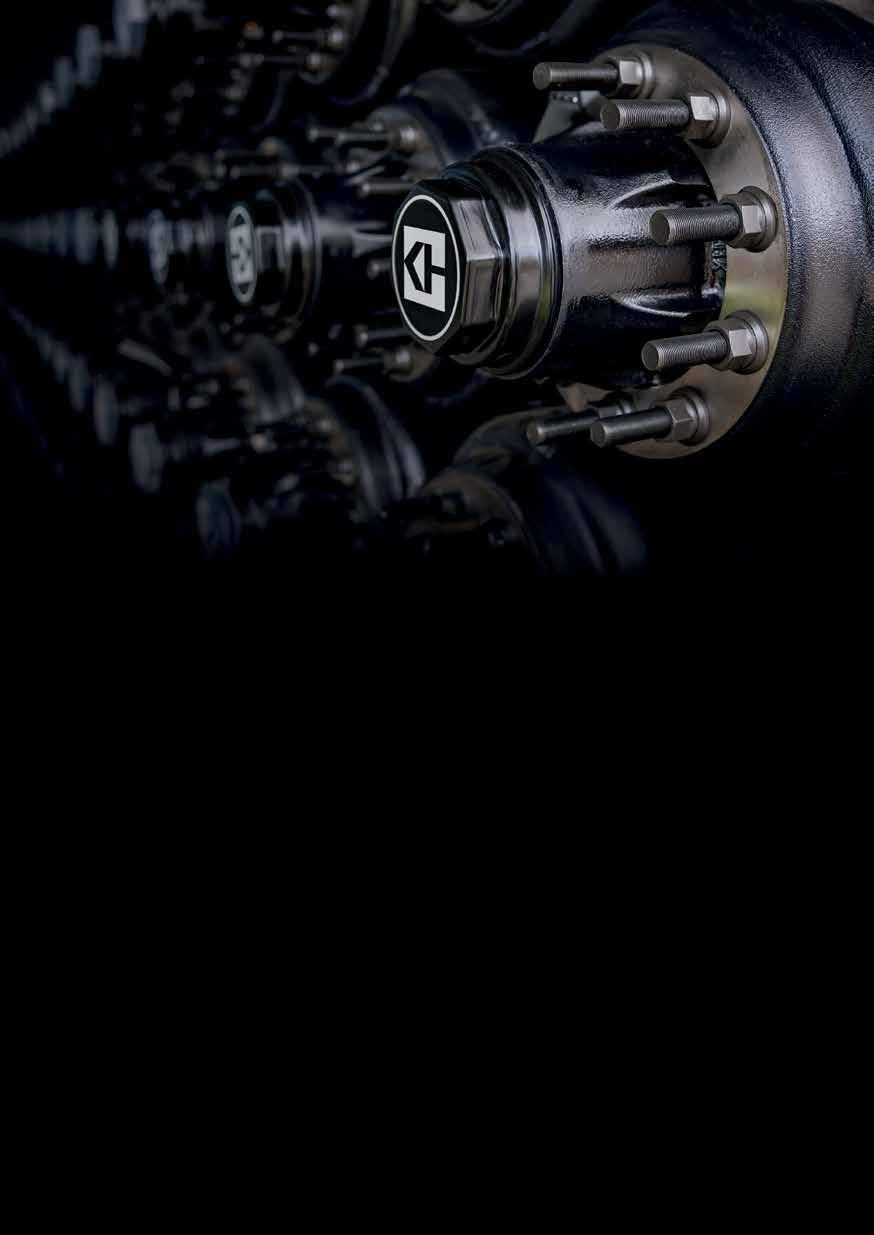






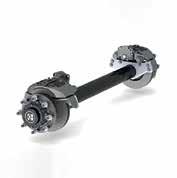

Victoria 13-21 Bliss Court, Derrimut VIC, 3026
Tel -(03) 9369 0000
Queensland 1/15 SeeanaPlace, Heathwood QLD, 4110
Tel -(07) 3372 2223



Western Australia
5 Freight Road, Kenwick WA, 6107
Tel -(08) 9350 6470
National Level Crossing Safety Roundtable
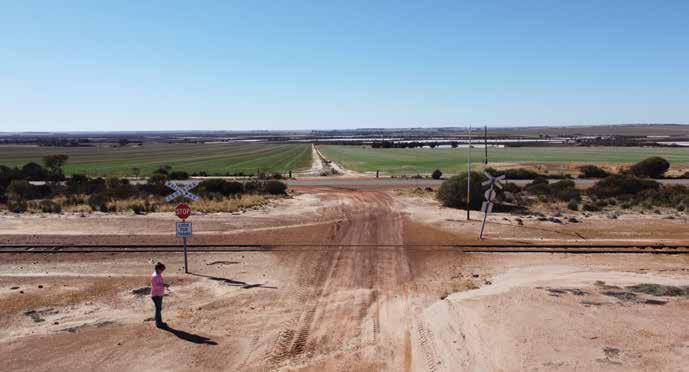
ATA CEO Mathew Munro and SARTA Executive Officer Steve Shearer OAM attended the National Level Crossing Safety Roundtable, officially opened by Federal Minister for Infrastructure, Transport, Regional Development and Local Government, Catherine King.
The roundtable followed a tragic New Year’s Eve truck and train crash on the Barrier Highway where two rail workers were killed. In February, Minister King released the National Level Crossing Safety Strategy 2023-2032.
Mathew said that improving level crossing safety was a responsibility that must be shared by governments, the rail industry and all road users.
“Truck and train collisions are statistically rare, with around seven occurrences in every 100 million passes of a level crossing. Internationally, the risks in Australia are very low,” Mathew said.
“However, when such incidents do occur, there can be catastrophic consequences for vehicle occupants, rail workers and others who attend the scene.
“The ATA strongly supports the National Level Crossing Safety Strategy and the priorities agreed at the roundtable.
“To improve road user education, ATA has partnered with the NHVR to release a National Level Crossing Safety Notice listing simple do’s and don’ts for truck drivers to remember. We have also committed to work with the rail sector and regulators on further education measures.
The National Level Crossing Safety
Notice reminds heavy vehicle drivers of the potentially life-saving safety measures they must adhere to around rail lines.
ATA CEO Mathew Munro said the safety notice was a part of a shared commitment to reducing fatalities and injuries at the more than 20,000 level crossings intersecting with roads and pathways across the country.
“Between 1 July 2014 and 31 December 2022, there were 39 lives lost and 49 serious injuries at Australia’s rail crossings,” Mr Munro said.
“These aren’t just numbers; these are people who didn’t make it home safely to their loved ones.
“There have also been thousands of near misses at rail crossings.
“We’re putting out a unified reminder for truck drivers to prioritise not only their own safety, but the safety of their fellow road users and rail workers.
“There’s no room to take risks when it comes to trains.”
NHVR CEO Sal Petroccitto OAM said level crossings presented unique challenges for heavy vehicles, meaning drivers needed to be aware of their surroundings and avoid any distractions when approaching rail lines.
“Trucks don’t have the same stopping time as lighter vehicles, so it’s critical all heavy vehicle drivers take extra caution around the tracks,” Mr Petroccitto said.
“The National Level Crossing Safety Notice includes simple do’s and don’ts for drivers to remember.
“These include reducing speed and checking blind spots before crossing,
adhering to any warning signs, boom gates and lights, and assessing the road condition.
“It’s imperative for truck drivers not to become complacent; a momentary lapse in concentration or judgement can be fatal.
“Even with efficient braking systems, it takes a considerable amount of time for a train to stop, especially when travelling at high speeds.
“Taking a risk at a level crossing is never worth it, and by following the guidelines in the safety alert, we can collectively reduce the likelihood of tragedy occurring and ensure all road users reach their destination safely.”
“The ATA supports a nationally consistent approach to driver penalties for disobeying road signage or flashing lights at level crossings. There must be zero tolerance f“It is equally important to prioritise actions to improve the visibility of trains and to make available real-time in-cabin warning systems.
“The ATA applauds the commitment of major rail companies Pacific National and Aurizon to fully implement the code of practice for train illumination when it is finalised later this year.
“In the longer term, we must also improve national safety data collection and sharing while upgrading level crossing infrastructure as budgets allow.
“In cooperation, governments, the rail industry and road users can improve level crossing safety. We all have an important part to play,” he said.
To read the National Level Crossing Safety Notice visit www.truck.net.au/ resource-library/safety-alert-
12 News WATM • April 2024
Image by Lara Jensen
Construction to start on Turkey Point Access Road and Bridge
The Turkey Point Access Road and Bridge, representing phase two of the major Bunbury infrastructure project, will soon be underway.
Funded by a $34 million contribution from the state Government, contractor Fulton Hogan has been engaged to build the dual-use path, road and bridge.
The project, which will connect Estuary Drive to Leschenault Drive, is a vital piece of infrastructure aimed at reducing traffic congestion and interaction between portrelated vehicles and public road users.
Construction follows a number of years of planning, which included environmental approvals, community consultation and engineering design to deliver the best outcome.
Phase one was completed last year, including site investigations, in preparation
for construction to begin in the first quarter of 2024.
Ports Minister David Michael said, “This Turkey Point access road and bridge is an important part of Southern Ports’ Port of Bunbury's Master Plan that will help unlock more trade opportunities for Berth 8 and future trade through additional berths.
“The project will also increase safety for the community and port users by diverting public road users away from the Port and providing direct access to Turkey Point.
“It is fantastic to see another infrastructure investment of the Cook Government progress to the next stage and provide regional employment opportunities.”
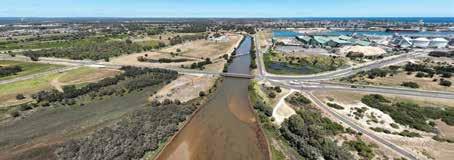
Skills for a decarbonised future - a survey
As a part of the 2024 Daimler Truck Future Leaders’ Forum, our industry future leaders are conducting group projects about what the future of the transport industry in Australia looks like. This year’s theme is the ‘Decarbonisation of the transport industry’.
ALRTA nominee, Ann Ferry, from GDP Transport, along with Patrick Stevenson (Daimler Truck) and Justin Khan (Qube Logistics) have been tasked with assessing the essential skills required for individuals pursuing careers in the trucking industry within a decarbonised road freight future.
Once completed, the groups will present their reports and recommendations to a minister/ ministerial adviser at Parliament House and to the delegates at Trucking Australia 2024. These recommendations will be used to guide future policy and decisions.
To assist them with their research, they have developed a survey to gain greater insight into industry members’ understanding and opinions of decarbonisation and the skills they feel are most relevant.
Please assist our industry future leaders by completing the survey at monash.az1.qualtrics.com/jfe/form/SV_ a2xh4TM5hk6WZiS
New lithium mine for WA
The WA Government has congratulated joint venture partners Covalent Lithium, Wesfarmers and Sociedad Química y Minera de Chile (SQM) on the successful opening of the Mt Holland lithium mine and concentrator project.
Premier Roger Cook, Treasurer Rita Saffioti and Mines and Petroleum Minister David Michael were on site to celebrate the occasion.
The Mt Holland lithium project consists of an open-cut mine and concentrator, located 110km southeast of Southern Cross in the Wheatbelt region, and a refinery currently being constructed in the Kwinana Industrial Area.
The state Government has played a key role in enabling this project by working with the joint venture partners to fund and deliver the Moorine Rock to Mt Holland road. This $60 million commitment has
improved road safety and freight efficiency, supporting the future growth of the mine.
With an expected cost of $2.6 billion, the project is supporting 1,000 jobs during construction and 350 jobs during operations.
Mt Holland will produce 380,000 tonnes of spodumene concentrate per year, which will be refined into 50,000 tonnes of battery-quality lithium hydroxide. This is enough to power around one million electric vehicles.
The Kwinana refinery is expected to deliver its first lithium hydroxide in early 2025.
Mt Holland mined its first ore in December 2022, and began crushing in May 2023. The concentrator was successfully commissioned in the second half of 2023 and is now in the ramp-up phase.
WA Treasurer Rita Saffioti said, "Our
Our $60 million commitment to support the Moorine Rock to Mt Holland road upgrades has been essential to getting this project off the ground
$60 million commitment to support the Moorine Rock to Mt Holland road upgrades has been essential to getting this project off the ground. Last year when the Australian Government withdrew their funding, we stepped up to fill the gap they had left and make sure the project was delivered.
News 13 WATM • April 2024

Over to you
WESTERN ROADS FEDERATION by Cam Dumesny, CEO
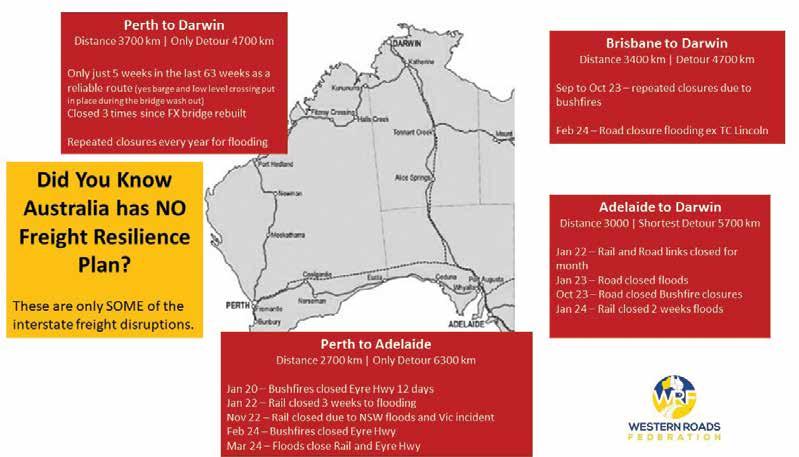
How many more Freight Disruptions do we need to have before Politicians care?
Freight route disruptions cost the economy, drive up the cost of living, put pressure on transport companies and above all keep drivers away from friends and family.
Whether its climate change or Huey is just in a bad mood, we seem to be dealing with more freight route disruptions.
Impacted businesses and communities scream in the media as local supplies run down or businesses can’t get their stuff to markets. The pressure mounts on our industry to come up with magical solutions to fix their problems.
Meanwhile, do they even give a fleeting toss about the truck driver stuck on the side of the road for a week with no toilets,
shower etc waiting for a bushfire to pass or a flood to recede?
Just in Time delivery only works when you have reliable logistics modes (road, rail, sea and air). Which we obviously do not have.
Quickly side tracking, what about the national defence implications? As regional tensions rise, Defence strategists and planners should be noting with deep concern that now in times of peace, our transnational freight routes are already vulnerable and barely able to supply the civilian population.
So, is it time to start thinking about Just in Case again, ie rebuilding buffer stocks in vulnerable areas?
But what else can we do?
What short to medium term practical things can be done to improve intra and interstate freight disruptions?
Here are ideas we came up with, you may have your own?
Road Train Parking
Similar to the concept of RFDS landing strips on highways, establish sealed Road Train parking bays along identified vulnerable routes. That can enable:
• Trucks and drivers to be consolidated into areas should resupply etc be needed on prolonged closures
• Road trains to be turned around if required, etc.
14 WATM • April 2024
Standing Arrangements on HPV Routes
Every time we need to get triple road train access through South Australia. Western Roads Federation has to initiate it, and then NHVR etc have to put in place legal notices. This can take days every time, despite the goodwill of all involved.
• Have a standing arrangement in place that can be implemented immediately if required.
Pre-Positioned Containers at Selected Roadhouses
During the Eyre Highway fires in 2020, one remote area road house was charging a mum with five kids $10 for a litre of water. It was the truckies that helped her out.
• So consider pre-positioning containers with emergency stocks at designated remote area road houses, to be cracked open when authorised.
Accelerate the Sealing of the Great Central and Tanami
Sealing these routes will provide alternative routes. At the current funding rates, it will be at least another decade before they are sealed.
Fix Vulnerable Points on Interstate Freight Routes
Identify areas of most frequent disruption and make it an infrastructure priority.
Alert System for Interstate Drivers and Transport Companies
We had the support of the other states and NHVR to implement an alert system for drivers and Transport companies on long haul interstate routes (excluding Victoria and New South Wales). Drivers often turn up at incident sties in another state; having no idea the road is closed.
Bush Fire Mitigation
The Federal Government needs to provide extra funding to Shires like Dundas, to help them reduce bushfire threats along the 700km of the Eyre Highway they manage. Seriously, the $23, 000 they were given was an insult.
What Ideas Do You Have?
Meanwhile, do they even give a fleeting toss about the truck driver stuck on the side of the road for a week with no toilets, shower etc. waiting for a bushfire to pass or a flood to recede?
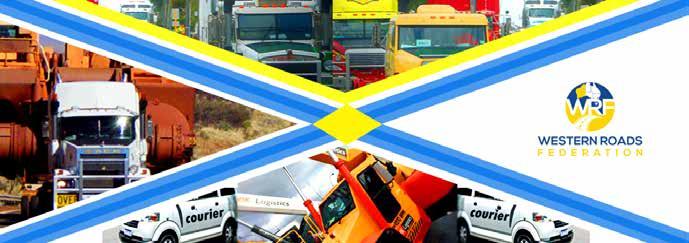
WESTERN ROADS FEDERATION IS THE UNITED VOICE OF WA TRANSPORT COMPANIES
Western Roads Federation has been formed to give a strong unified voice for companies who use WA roads for commercial benefit.
Western Roads Federation is a membership driven organisation. If you believe in the industry and what you do, then make sure your company is a member, and get involved.
15 WATM • April 2024
For a membership application form
cam.dumesny@westernroads.com.au ◆ Phone 08 9365 7799 or 0481 064 371 180 Hay St, East Perth WA 6004
Email
Clarification of ‘right to disconnect’ laws within transport sector
Owner Drivers to get more say
Following the recent passage of the Closing Loopholes Bill, industry bodies sought to clarify the application of the new ‘right to disconnect’ laws within the trucking sector.
In a meeting with the ATA, the Australian Livestock and Rural Transporters Association, and the Western Roads Federation, the Office of the Minister for Employment and Workplace Relations, Tony Burke, advised—
• Employees will have a ‘right to disconnect’ which includes refusing to monitor, read or respond to contact, or attempted contact, from an employer outside of work hours –unless the refusal is unreasonable.
• In determining what is ‘unreasonable’ factors such as the nature of the employee’s role, level of responsibility and whether the employee is compensated to remain available to perform work must be considered.
that the employee stop refusing contact or take certain actions.
• In response, the FWC may make any type of order it considers appropriate (other than requiring the payment of a pecuniary amount).
• Vexatious or frivolous actions by either party can be dealt with expeditiously.
• Contravening an order is a civil offence only (criminal offences have been removed from the original bill).
The ATA says they will work with the Fair Work Commission in the development of clearer guidelines for our industry and that their members have raised concerns such as differences in time zones, operational requirements, driver welfare checks, evolving schedules and emergency management.
Industry bodies sought to clarify the application of the new ‘right to disconnect’ laws within the trucking sector
• Importantly, there is no prohibition on employers contacting employees.
• If an employer believes that a refusal is unreasonable, and the situation cannot be resolved at the workplace level, an employer can apply to the Fair Work Commission for an order
ATA CEO Mat Munro also met with the Shadow Minister for Employment and Workplace Relations, Michaelia Cash, to discuss the Opposition’s view on the ‘right to disconnect’ law and other provisions of the Government’s workplace relations reforms.
The ATA will liaise with all sides of the political spectrum on these and other matters in the countdown to the next Federal election, to be held on or before 27 September 2025.
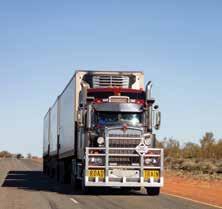
Owner drivers will get more say in advising the Fair Work Commission on road transport, following amendments to the Government’s closing loopholes bill which has passed both houses of parliament.
The bill will set up a Road Transport Advisory Group to advise the commission.
As a result of amendments moved in the Senate, Owner Drivers or their representatives must be in the majority on any RTAG subcommittee that considers road transport orders that cover or affect Owner Drivers.
The Senate committee report on the bill recommended that the Government look at requiring that Owner Drivers or their representatives be included on any RTAG subcommittee when minimum standards orders covering Owner Drivers were considered.
Industry bodies argued that Owner Drivers or their representatives should hold a majority of positions on these subcommittees.
New high-tech driving simulator for WA
Anew State Government-funded hightech, custom-made driving simulator is set to help researchers at the University of Western Australia make WA roads safer.
The simulator, the only one of its kind in the world, will be based at UWA's Western Australian Centre for Road Safety Research, enabling researchers to test the safety of new road designs.
Jointly funded by the Road Safety Commission ($450,000), Main Roads WA ($160,000) and UWA ($100,000), the simulator will provide new opportunities for researchers to study a wide range of road safety issues with a high degree of realism - all free from the risk of a crash.
Research opportunities include:
• testing new road layouts;
• assessing driver distraction from roadside advertising;
• studying at risk groups such as young and older drivers; and
• testing the impact of the use of drugs, fatigue, and alcohol on driving skills.
The simulator will enable collaboration between researchers across multiple disciplines including road safety, engineering, ophthalmology, psychology, physiology and mathematics.
The simulator has the advantage of:
• Adaptability - controlling and
manipulating input variables such as behaviour of virtual traffic and pedestrians, weather conditions, and road design;
• Repeatability and standardisationparticipants can drive under exactly the same conditions;
• Ease of data collection - accurate and efficient measuring of driving performance; and
• Safety - safe environments free from crash risk and physical harm allowing drivers to be exposed to hazardous situations in a systematic way, which can be difficult to study in a natural driving environment.
News 16 WATM • April 2024
Over to you

MDealing with DoT
aybe I should have titled this ‘attempting’ to deal with DoT because from our experience actually dealing them is getting harder and harder to the point where it is getting ridiculous.
I’m sure we all remember the days when we could just pop into our local licensing centre in our lunchbreak and attend to whatever licensing matter we needed – a new photo for our drivers licence, hand in some plates, pickup new plates or for those new drivers – a hazard perception test or sitting the test for a learners permit but sadly this is no more.
These days it is a long trek to even find a licencing centre and then a minimum of an hour and often two or three hours wait to be attended to and I find it totally unreasonable.
The Government has cut the number of licencing centres to the bone (and beyond). If you don’t count Rockingham and Mandurah as they are hardly metropolitan – (you need a cut lunch and waterbag to go there) – the only ones left are Butler and Joondalup in the North, and Cannington, Midland, Mirrabooka, Success and West Perth in the central area. All the others seem to have been closed down.
Instead of increasing the opening hours to allow staff to process all the transactions that the Government require that we do, staff just tell the customers – that’s you and
me the taxpayers, “Sorry, you have to come back tomorrow.”
This is after a 20 odd minute drive down to Cannington, parking, queuing standing up in the sun for over half an hour whilst staff came out and arbitrarily cut the queue of six people in front of my husband and told him and everyone behind him to go home and come back tomorrow.
How is this fair to people who are trying to earn a living if they are not going to be able to attend to you on that day, then get everyone inside that will be attended to and close the door and put a sign up.
Would it not have been more considerate to at least not make them queue for 30 minutes in the sun before telling them you won’t attend to them? How unprofessional and how incredibly rude and disrespectful. They tell you to come back in the morning with no disregard to the fact that you have a life and are busy and when you do attempt this again in the morning and there is a queue right around the building well before they even open.
Another friend attended at Midland and was turned away at 3.30pm and told that there was at least a two hour wait to be attended to.
After talking to other people I find this is a regular and ongoing problem... So why isn’t something being done about it?
There are several easy solutions to the
problem. First, hire more staff who can attend to more people.
Secondly, extend the opening hours. Start an hour earlier and finish an hour later or have some staff start early and some staff start later – more hours open means more people can be attended to. Thirdly, and this is really is the easiest solution return the queues like they used to be. It only needs to be a mini queue of maybe three people but then as soon as one person is finished the next is right there.
The current system of, ‘Ticket B36 to counter 15” is such a slow and laborious system. Ticket B36 (along with everyone else) has fallen asleep due to the boredom of waiting an hour and needs to be called three times before he responds, looks around and then makes his way over to the counter at the other end of the room losing three or four minutes.
But it’s not just three or four minutes, it’s three or four minutes for ‘every’ customer so by the time the end of day comes you have easily lost a couple of hours.
If we can recognise and offer solutions to the problem why can’t the DOT supervisors? Why can’t someone use a bit of initiative?
Sadly it seems they are paid the same whether they attend to two customers or 22 customers so there is no incentive to be more productive. So we the customers lose out again. Sound familiar?
17 WATM • April 2024
BIRDS EYE VIEW by Carol Messenger

Recently, the Livestock & Rural Transport Association of WA (LRTAWA) bestowed life membership of their association to two long serving members -
John Mitchell and Rod (Wally) Stanbishop
If you take, you should give back – words to live by I

Nominations open for Work Health and Safety Excellence Awards
Nominations are now open for the prestigious 2024 Work Health and Safety Excellence Awards, rewarding and celebrating health and safety initiatives across Western Australian workplaces.
This year's Award categories are:
• Work health and safety invention of the year;
• Best solution to a work health and safety risk;
• Best intervention to address a psychosocial hazard in the workplace;
f variety is the spice of life, Rod Stanbishop has had a feast for the senses. Born in Mount Barker, Wally as he is affectionately known, shared his youth between the country towns of Waterloo, Picton and Mount Barker finishing his school life at Denmark Agricultural School. On leaving school he bought an FJ Holden, packed a suitcase and handpiece and went shearing until he was old enough to drive a truck.
His appetite for driving trucks had been whetted as a 16 year old when he joined his uncles who owned Stanbishop Brothers. In those days they were transporting two-three loads of baby beef per week through to Midland from Mount Barker.
Like many boys in the 60’s and 70’s, Wally got a taste for trucks when he was allowed to steer the trucks on the open road after dark. By 1978 he had his truck licence and headed for the Kimberley working for Geraldton Earth Moving which included periods in the Great Sandy Desert undertaking seismic exploration work, finishing as an on-site supervisor.
• Leadership excellence; and
• Health and safety representative of the year.
There are two Awards in each category – one for small business (199 employees or less) and one for large business (200 employees or more) – to ensure all sizes of business have an equal opportunity to win an Award.
Further information on the Award categories, entry requirements, and assessment criteria is available on the WorkSafe website at www.demirs.wa.gov.
18 WATM • April 2024
News
LRTAWA by Jan Cooper Chief Executive Officer, Livestock and Rural Transport Association of Western Australia (Inc)
LRTAWA President Darran Bairstow and Rod Stanbishop
When Geraldton Earth Moving was sold, Wally headed back south to Kojonup driving for Matthews Transport and later Katanning Livestock, Symingtons and Southern Haulage. In 1987 he, and partner Rosa, bought Wally’s Transport in Kojonup. Unfortunately, Wally had a date with destiny and in 1994 he had a serious accident where his legs were badly broken. A future in transport looked doubtful and the business was sold while he concentrated on his recuperation. Returning to his roots was ideal therapy and for a period of time he grew vegetables on his farm in Denmark.
The road ahead looked uncertain. The medical profession was convinced that he could not work again and advised him to go on an invalid pension. Anyone who knows Rod would understand that this suggestion would never find fertile ground. With characteristic grit and determination he went contract hay baling and harvesting. To keep up with the header he acquired an N Series Volvo to cart grain into Kojoneerup which became the genesis for the next enterprise, Kendenup Bulk Haulage. Kendenup Bulk Haulage expanded to five trucks and at the peak of harvest up to nine contractors.
Wally has always appreciated the support and good will of local farmers. He holds to the credo that if you take, you should give back and make it better for the ‘young fellas’ coming after you. For this reason he committed to the LRTAWA over many years. This was no easy task. He would reluctantly leave his Kendenup based business on Friday night in time for an early Saturday meeting, with Rosa’s words ringing in his ears- ‘don’t worry, it will all be here when you get back!’
Initially he joined as a driver associate member near the time of the association’s
inception and has remained a member ever since. He saw a group of people trying to achieve something for the industry when no-one else was looking out for them and felt he had to be part of it.
In 1993 and 1994 he was elected vice president and a long period of representation on the committee ensued until 2017 when he stepped down to begin the process of winding back. Notwithstanding his absence from the committee, Rod has remained actively engaged with the LRTAWA which has been made easier by his ongoing role piloting oversize loads throughout Western Australia.
During his time on the committee Rod has taken an active role in helping to ensure
that transport reforms are sympathetic to rural transporters. He has been vocal about the expansion of the road network and a protagonist for safety, a passion he has carried forward in his piloting work where he is known for his high standard of service. He helped the association navigate the new style of animal activism and remains concerned that agriculture is under threat and that this will affect rural transporters badly.
With a reputation for doing things properly, Rod would like to see professional transporters supported more fully in contrast to those that may own a truck and use it as an adjunct to their principal operation. A man of vision, he is a worthy recipient of the life membership honour.

au/safetyawards.
Nominations close on May 31, and the winners will be announced at an Awards ceremony in October during Safe Work Month.
Industrial Relations Minister Simone McGurk said, “This is a terrific opportunity for local businesses to show off their workplace health and safety initiatives and to receive some well-deserved recognition.
“I encourage companies and individuals to consider nominating for the Awards and take advantage of this great
promotional opportunity.”
Last year, the winner of the Best solution to a work health and safety risk – 200 employees or more was the City of Canning who developed a bespoke engineering solution, the LBin Tail Lift Platform, in collaboration with workers and Contained Waste Solutions in order to mitigate several hazards associated with delivery vehicles fitted with tail lifts that present at the Resource and Recovery Waste Transfer Station (RRWTS).
The platform was designed to provide a safe work area between trucks’ tail lift platforms and the waste disposal edge by ensuring a flat, slip resistant work platform, installed with handrails, steps and edge protection. This solution mitigated the risks of falls from height (up to two metres) from vehicle tail lifts, working in proximity to heavy machinery and musculoskeletal injury from climbing on and off the tail lift and moving bulky items over a barrier for disposal.
19 WATM • April 2024
Rod Stanbishop and John Mitchell
The rail industry needs to stop redirecting blame
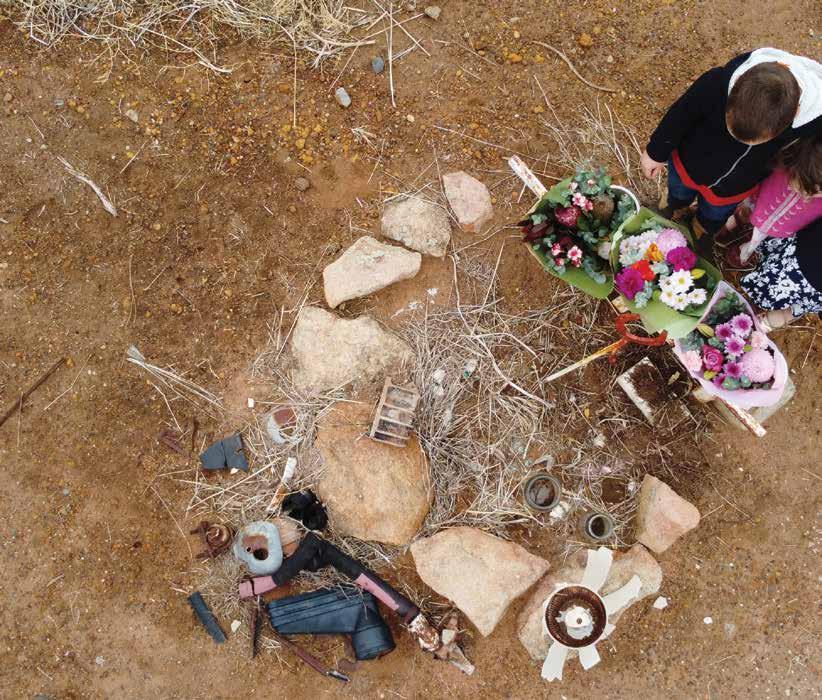
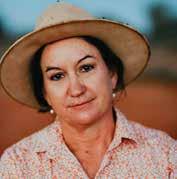 By LARA JENSEN
By LARA JENSEN
In March a National Level Crossing Safety Roundtable was held in Brisbane following the tragic deaths of two Pacific train drivers on New Year's Eve when a train collided with a truck at a level crossing near Bindarrah on the South Australian border.
Every death on the rail network is a tragedy, and the loss of these two train drivers is absolutely devastating for work colleagues, friends, and family. So too are the deaths of those who have lost their loved ones in road vehicle collisions with trains at level crossings.
I represent 12 such families (of rail crash victims around Australia) who have been joined by more than 20 organisations nationally. Half of our group lost family
members who were driving heavy vehicles when they lost their lives in collisions with trains at level crossings. Collectively, we are calling for rail safety reform and for the corrective actions pointed out by coroners, safety investigators and committees around level crossing safety and train lighting to be finally actioned to prevent further unnecessary loss of life.
None of our families were invited to the roundtable in Brisbane so we had no chance to be part of the national dialogue surrounding level crossing safety. We have collectively looked on in complete disbelief at just how easy it was for the rail industry to secure a national safety summit with full government support in a matter of weeks
Focus 20 WATM • April 2024
Memorial near Yarramony Crossing

following the Bindarrah tragedy.
Yet, the sad truth of the matter remains that nobody from the rail industry, including the company involved in our accident, Westrail, ever came forward when my brother and his two friends were struck and killed by a fully loaded grain train at a notorious crossing near Jennacubbine in the WA Wheatbelt on July 8, 2000. Furthermore, Westrail vehemently resisted our families’ pleas to make any improvements whatsoever to train lighting following the unequivocal recommendations for immediate action to improve it by WA State Coroner Alastair Hope in 2001. We didn’t get a roundtable, a safety summit, any genuine remorse, or
any commitment whatsoever to improve train lighting and here we are twenty-three years later still fighting for these lifesaving improvements.
Aside from the roundtable, our families are acutely aware that when it comes to train illumination specifically, the waiting game is far from over. It is still unclear what the outcome of current planned Monash Institute of Railway Technology train lighting trials will be or what will be contained in the report to follow. In addition, we are also awaiting the forthcoming RISSB review of AS 7531 (the third in as many years) and the development of a Code of Practice on level crossings and train visibility being developed by the Office of the National Rail Safety Regulator.
What is entirely clear though, is that the last two decades have been marked by a complete failure to improve level crossing safety or train illumination. Rail operators have done nothing in the face of clear evidence their safety practices can be improved, the national rail regulator ONRSR has done nothing to ensure they act on the evidence, and Transport Ministers have not been actively engaged or taken their responsibilities seriously.
That the rail industry needs to stop consistently redirecting blame onto motor vehicle drivers and look at its own actions – or lack thereof, for the benefit of their own employees in addition to motorists that interact with their trains and rolling stock at regional level crossings. Cars and road transport have seen enormous safety upgrades over the decades. Seatbelts, safety glass, reverse cameras and airbags have helped reduce the road toll. In mines and on construction sites, vehicles are fitted with rotating beacons to help warn of their approach. So are the largest heavy vehicles. They all help save lives. The rail industry has not kept pace. It is quite literally stuck in the ‘dark ages’ with safety.
In the trucking industry, flashing lights are used as the accepted indicator to warn motorists of a hazard on our roads, yet trains, which hurtle across more than 20,000 level crossings in the country are often up to 1.8km long, have lighting that is little more than what you see on motorbikes. Most regional crossings don’t have boom gates or flashing lights and with trains often operating in the dark, it is an extremely dangerous combination as multiple investigations have found.
Coroners, safety reviews, the Monash Institute of Railway Technology and
The rail industry needs to stop consistently redirecting blame onto motor vehicle drivers and look at its own actions – or lack thereof
numerous committees have recommended better lighting, such as rotating beacons or strobe lights, on trains. The rail industry has refused to budge. The Rail Industry Safety and Standards Board RISSB (owned and controlled by rail operators) has rejected multiple submissions calling for rotating beacons and wagon side lighting from road safety groups, road transport associations, community organisations and independent professionals that all recommended better lighting and provided the justification for their use to improve safety for all road users.
Public safety should be transparent, but we know from our experience with the rail industry that it isn’t. By this I am referring to the standard governing train and rolling stock illumination, AS 7531, and how it is applied and enforcement.
The fact that rail operators interact with road users at more than 490 unlit, unprotected crossings in WA alone suggests to me that that train and rolling stock illumination is an important industry and public safety issue, so standards like AS 7531 should be open to comprehensive public scrutiny and not sit behind a paywall as is currently the case.
We are all completely baffled by the rail industry and government stonewalling in the face of clear evidence that additional visibility lighting improves safety. To give an example, the rail industry already has rotating beacons fitted to the roofs of vehicles used for transporting personnel and on the roofs of track machines used for conducting rail maintenance and their trucks used for road transport. Yet the rail companies don’t put the same lights on their trains. Cars can stop reasonably quickly. Trains cannot. Their impact is devastating.
Focus 21 WATM • April 2024
Over to you


Original is Good
By MORRIS & COLIN DANKS
Our first 1926/27 Chev Truck was given to Morris by Ray Tilbrook and it was originally working around the Goomalling district. Fast forward to 2012, after it had been sitting around for 40 odd years, it came to Esperance and we got her running about three years later.
It spat some crap out of manifold when she fired up but not much has been done to it since as far as the restoration goes. A good reliable vehicle, it has been travelling to shows and events all over the state.
Our second 1925 Chev Truck came from Jumbo McAlpine of the Miling and Geraldton farming area.
Jumbo contacted Jan Muller from Carnamah Historical Museum regarding two Chev trucks looking for a good home. Jan contacted Marbles from Geraldton and asked if he was interested, he said no as he's a tractor man - having 70 of them, but he knew a guy in Donnybrook (Colin) who
would be very grateful. A big thanks to Jumbo and family. Sadly, Jumbo passed away not long after that in June 2023.
Our third truck a 1948 Dodge Fargo 1 and it was originally owned by Roy Gould in Kukerin. The farm was sold to Daniel Gooding and the Fargo that had been parked in the shed was given to Colin.
We gave the truck a tow start and drove it to a neighbouring farm about 35 km away. It took 10 km before the clutch released and we were actually able to stop it. From the neighbours farm it was transported back to Donnybrook.
The truck was last licenced in 1972 and we found some old CBH delivery dockets in the glovebox. They had been signed by guys that Colin had been at school with. We are now changing the oil in it and getting it ready for the Mack Muster. All three trucks will be there.
We gave the truck a tow start and drove it to a neighbouring farm about 35 km away. It took 10 km before the clutch released and we were actually able to stop it
22 WATM • April 2024
They always draw a crowd this time at Dowerin Field Day

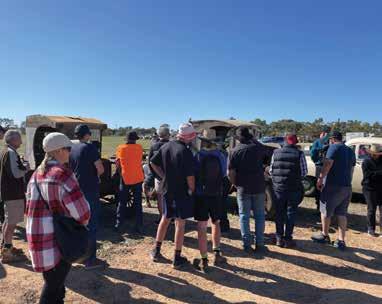


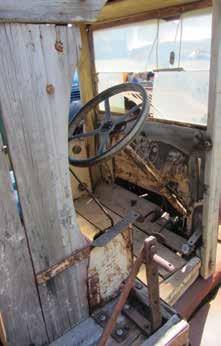

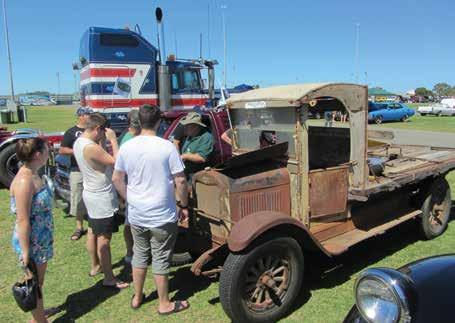
23 WATM • April 2024
They always draw a crowd this time at Dowerin Field Day
Chev
Under the bonnet
cab
The three unrestored trucks
At Kwinana Show and Shine 2017
Fargo as found in 2016
Above, Colin driving one of the Chevs in the parade, Dowerin 2023
The
History
The History of the West Australian Road Transport Industry

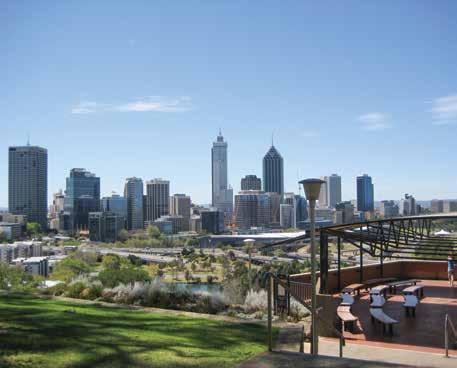
2007
The March 19 Board of Management Meeting was told that the value of the land in Carlisle had gone down since the last valuation.
Leach Highway trucking restrictions came into place on March 25. Trucks over 12.5m no longer had access to Leach Highway between Albany Highway and Kwinana Freeway, and also not on South Street between Roe Highway and Kwinana Freeway. Container trucks were also banned from South Street between Kwinana Freeway and Stock Road.
Ray Gannaway reported that the demographic of school bus operators was changing to multi-contract operators.
The Forum intimated its willingness to be a part of the 2009 Truck Show.
A Board of Management File was instituted for all Board members, outlining
duties and other important details.
Former WARTA Chairman Brian Sharp passed away on April 14. He served in the top role in 1981-83, was Vice-President for two terms before that and served on the Executive Council four years earlier.
The 4.2km Mt Barker Northern Bypass opened at a cost of $13.3 million, allowing motorists using Muirs Highway to access Albany Highway without travelling through the town centre. It was part of the Labor Government’s $30 million, three-year commitment to the region, upgrading major sections of the 161km Muirs Highway between Mt Barker and Manjimup.
Chairman Derek Nathan and CEO Ian King attended a meeting in Bunbury of interested parties, with 89 people turning out. The main issue was draw bar lengths, Ian reported to the April 22 Board of Management Meeting.
The Australian Transport Safety Bureau
By Russell McKinnon
released a report stating that of 12 levelcrossing accidents between April 2006 and December 2007, nine involved heavy road vehicles, leading to 19 deaths, 60 injured and a damage bill of $100 million. Last year saw 34 more deaths on WA roads than in 2006 (235 in 2007 and 201 in 2006).
On May 2, Australia’s Transport Ministers agreed to begin an ambitious programme of national reform to address significant challenges across all modes — passenger and freight — including climate change, safety, efficiency, congestion and the skills crisis.
Reported in the May 9 Friday Communiqué, there has been a 1200 percent increase in the number of containers moving through Fremantle Port by rail since 2002 — from 7000 teu (container equivalents) annually to an estimated 84,000 teu in 2008. Planning and Infrastructure Minister Allanah MacTiernan said the volume of freight would have required an estimated 65,000 truck movements through the port.
The world’s first LPG-powered truck was unveiled in Melbourne early in May at the inaugural International Trailer, Truck and Equipment Show. The 2656 FPC Envirotech uses patented technology to re-engineer a Mercedes-Benz Actros 12-litre V6 diesel prime mover to run on 100 percent LPG.
May 23 was the last day of work at Transport Forum for Julianne Olsen after eight years in the office.
The WA Freight Group won the Award for Training Excellence at the National Trucking Industry Awards. Stewart Beard accepted the award on behalf of WA Freight Group, speaking passionately about the importance of training, especially in the current economic arena.
Chairman Derek Nathan made a marketing and membership drive to the Geraldton region in July, visiting 11 companies in two days.
24 WATM • April 2024
Perth from Kings Park, September 2008



The Livestock and Rural Transport Association of Western Australia (Inc) is the only transport association in WA specifically representing rural transporters.
We are a strong voice for rural WA, ensuring that policy decisions support the viability and safety of rural transporters, primary industry and the communities they service.
Members of the Management Committee are hands on business people, most of whom would drive a truck weekly and travel on nearly every road in WA’s 150,000 km road network in the course of a year.
This close proximity between transporting operations and the advisory role means that representatives of the Association are at the coal face and as such are able to provide that all too rare practical hands on advice in committees, consultative forums and meetings.
MEMBERSHIP ENQUIRIES
Ph 08 9208 0320 or email admin@lrtawa.org.au
www.lrtawa.org.au

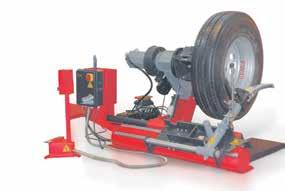
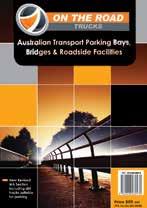

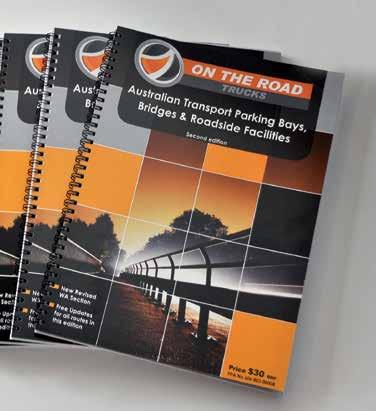



25 WATM • April 2024 18/9 Inspiration Drive Wangara WA 6065 PHONE: NEVILLE BAKER 0419 515 151 www.tyreequipment.com.au sales@tyreequipment.com.au TYRE EQUIPMENT TRUCK TYRE CHANGER TRADER YOUR SPACE This space could be your spot to reach over 10,000 readers in the Western Australian transport and associated sectors. Contact Karen at Karen@angrychicken.com.au or Ph 0430 153 273 ON THE ROAD The ‘must have’ book for transport operators giving you the locations (distances) of Transport Parking Bays, Bridge information, roadside facilities and their services throughout mainland regional Australia. Hurry Limited copies left Only $30 plus postage TO ORDER visit www.angrychicken.com.au karen@angrychicken.com.au Having trouble finding space in rest areas? WA GRAVEL TRACKS in this edition TRUCKS FRESH OFF THE PRESS Australian Parking Bays, bridges and roadside facilities HARD COPY POSTED TO YOU Last published in 2010 (note, no updates – this is a reprint only), On the Road – Trucks gives you the distances (pegs) of truck parking facilities, bridges and roadside facilities nationally plus suitable dirt tracks in Western Australia. Printed with a hard cover, wire bound A4 format, the internal pages can be easily written on so you can keep your own notes. $50 plus postage within Australia * Can be picked up from Henley Brook, Western Australia. ALSO AVAILABLE IN DIGITAL FORMAT – $30 Can be printed or stored on your phone and is emailed to you in PDF format To receive either option, email karen@angrychicken.com.au with your name, company name and postal details (hard copy), or nominate the PDF copy and you will receive a tax invoice with EFT details Angry Chicken Publishing Pty Ltd | M 0430 153 273 Route Route Guide Midland to Wyndham Wyndham to WA/NT border (Victoria Hwy) Muchea Geraldton Geraldton to Hedland Bindoon to Dongara Wubin to Mullewa North West Hwy to Onslow North West Hwy to Exmouth Nanutarra Tom & Paraburdoo Tom Price Ring Road Great Northern Hwy to Paraburdoo The Lakes to Merredin via Northam Pithara Geraldton Leinster Mt Magnet Newman to Gt Northern Hwy via Nullagine Marble to Telfer Woodie Woodie Perth to Kalgoorlie Order Form Coolgardie to Esperance Norseman to WA/SA Border, Border Village Kambalda Meekatharra Leonora to Warburton Laverton Kelmscott to Ravensthorpe Roelands Lake King via Collie Free Updates for OTR Perth NorthamAlbanyCranbrook Albany to RockinghamEsperance (Perth) to Bunbury via Mandurah Armadale to Albany via Pinjarra & Bunbury Border Village SA/WA Border to Port Augusta 51-53 Ceduna to Port Lincoln Port Augusta to Port Lincoln Port Augusta to SA/NT Border via Coober Pedy Port Augusta to Adelaide Warnertown to Monash Renmark SA/NSW Border 57 Warnertown to Peterborough Jamestown Gawler to Cockburn SA/NSW Border 59-60 Adelaide to Paringa Border Tailem Bend to SA/Vic border Pinnaroo 61-62 Adelaide SA/Vic Border Gambier Tailem Bend SA/Vic border Bordertown Keith Mt Gambier NSW/SA Border Nyngan 64-66 Nevertire Coonabarabran 67-68 Nyngan to Narromine 68 Coonabarabran NSW/Qld Border Goondiwindi 69-70 Dubbo INDEX Meekatharra Newman Port Hedland Broome FitzroyCrossing HallsCreek Kununurra Wyndham Mandurah BunburyBusselton Geraldton Exmouth Karratha Price Paraburdoo Magnet Newcastle Waters Daly Waters Alice Springs Coober Pedy Newcastle Port Macquarie Harbour Grafton Lismore Tweed Heads Maroochydore Emerald Rockhampton Mackay Townsville Charters Towers Marla Dongara Manjimup arburton Mullewa Derby Richmond Roma Onslow Moora Leinster MarbleBar LavertonLeonora Kulgera Broken Hill Dubbo Wilcannia Narromine Coonanarabran Nyngan Goondiwindi Moree Narrabri Singleton Katherine Tennant Creek Camooweal Mt Isa Cairns Winton Cloncurry Blackall Toowoomba Barcaldine Millmerran Barringun Bourke AugathellaCharleville Belyando Carnarvon Perth Darwin Brisbane Tamworth Glen Innes Muswellbrook GilgandraDunedoo algett George Hebel Ballina Coral Bay Woomera Normanton LyndJunction MountMossmanMolloy Clermont Longreach Gladstone Maryborough Biloela Springsure Westwood Nanango Dalby Cunnamulla Ipswich Warwick Caboolture Three Ways RoadTrucks Final.indd 22/11/10 to fuel. showers. accommodation. workshop Meekatharra Wubin Miling Dalwallinu Cue Newman NORTH alebing Paynes Find Oudabunna New Hwy Tuckanarra Katalundie Roadhouse Mt Magnet Wydgee Kirkalocka Capricorn Roadhouse NORTH Hwy Munjina Roadhouse Great Northern 167 Bindi 177 West ColvinsRoad Both MilingHotel Fu Park 204 East PiperMcNeillRoad 220 East PitharaGrain West CourtleaRoad Dallwallinu Shelter 241 East NugudongRoad 248 West Wegners Wubin Fu.F.T.S.Phone 254 N/East JimberdingRoadhouseWubin Fu.F.T.S 255 North WubinRoadTrainArea Wubin East SymesCrossing Shelter 275 East Jibberding Shelter 288 East GoodlandsPark 300 West The Shelter East Gibson 337 Gibson 357 West MtSingleton 370 East Ninghan 386 West NyoundaHills 398 East MtHarry 402 East MtEden West PaynesFind T.S ThundelarraPass 438 West Oudabunna 446 East NarndeePark Cooladar 478 Kirkalocka 484 East CooloalooHills West Wogarno Meeline GravelPit 524 East Iowna 548 West JumbulyerHills 551 East MtMagnetRoadhouse 552 West SwagmanMtMagnetRoadhouse Fu.T.S 553 MtMagnetCreek 571 Both Wandarriet/o 606 East AustinTownsite UtePark 609 West LakeAustin 617 West MainlandStation West DairyFlat Km Side Bridge Peg Road Name Comments Services WA Great Northern Hwy 95. 1. Midland to Wyndham Continued Final.indd 22/11/10

26 WATM • April 2024 TWU Nominees Pty Ltd, ABN 67 002 835 412, AFSL 239163, is the trustee of TWUSUPER ABN 77 343 563 307 and the issuer of interests in it. TWUS 7267 Strong long-term performance* Transport ready insurance Service tailored for transport workers Join the super fund for people who work in transport Behind everything you do, are transport workers - delivering our food, fuel and online shopping, as well as taking us to school, work and on holidays. And behind them is TWUSUPER, the industry super fund for the people who keep the country running. Behind the people who keep Australia moving Prepared and issued by TWU Nominees Pty Ltd ABN 67 002 835 412, Australian Financial Services Licence No. 239163 (‘Trustee’) on 18/08/2023 as trustee of TWUSUPER ABN 77 343 563 307 (‘TWUSUPER’ or ‘the Fund’) and the issuer of interests in it. Before making any decision to invest you should consider the PDS and TMD which are available at twusuper.com.au. * Past performance is not a reliable indicator of future performance and should never be the sole factor considered when selecting a fund. TWUS 8988

























































 By LARA JENSEN
By LARA JENSEN





















